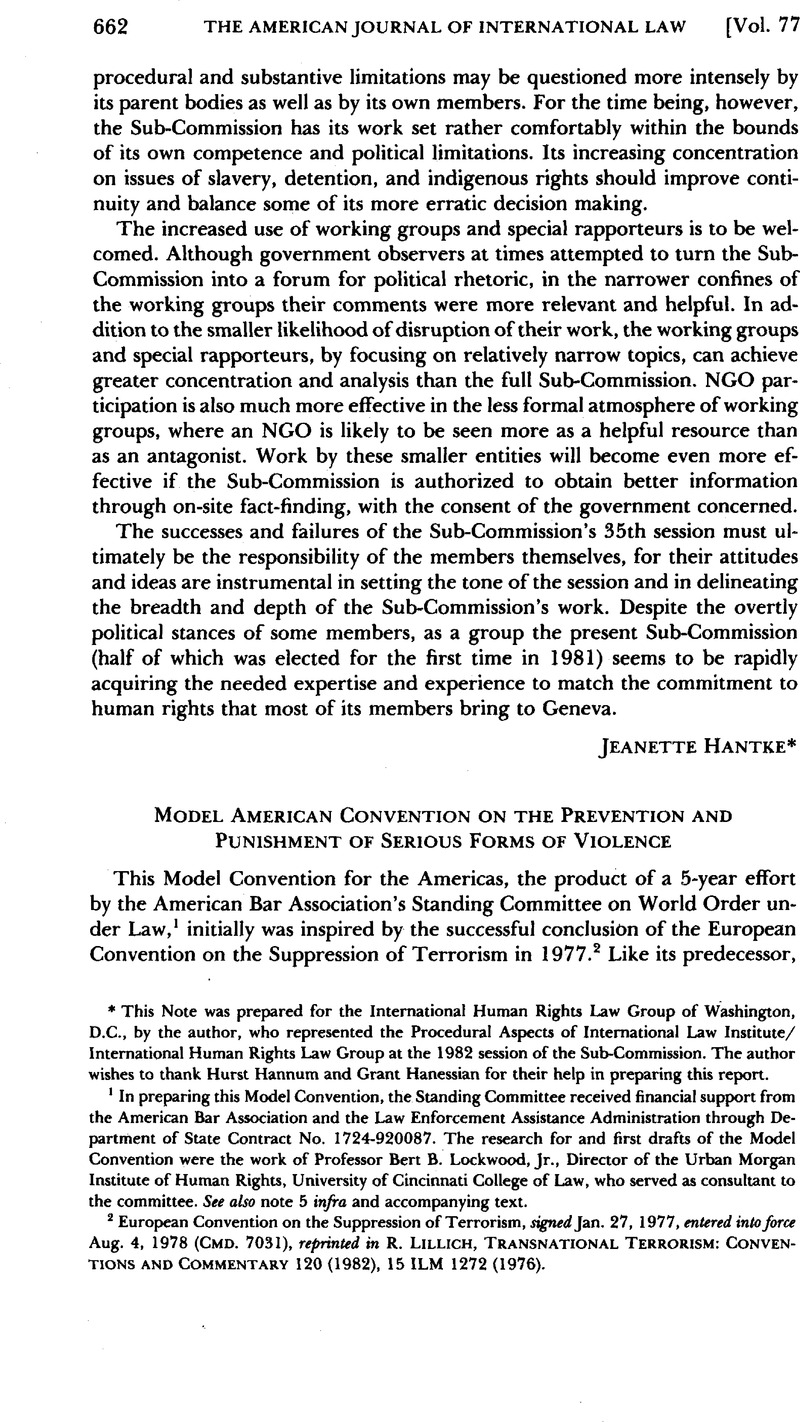Article contents
Model American Convention on the Prevention and Punishment of Serious Forms of Violence
Published online by Cambridge University Press: 27 February 2017
Abstract

- Type
- Current Developments
- Information
- Copyright
- Copyright © American Society of International Law 1983
References
1 In preparing this Model Convention, the Standing Committee received financial support from the American Bar Association and the Law Enforcement Assistance Administration through Department of State Contract No. 1724–920087. The research for and first drafts of the Model Convention were the work of Professor Bert B. Lock wood, Jr., Director of the Urban Morgan Institute of Human Rights, University of Cincinnati College of Law, who served as consultant to the committee. See also note 5 infra and accompanying text.
2 European Convention on the Suppression of Terrorism, signed] an. 27, 1977, entered into force Aug. 4, 1978 (CMD. 7031), reprinted in Lillich, R., Transnational Terrorism: Conventions and Commentary 120 (1982)Google Scholar, 15 ILM 1272 (1976).
3 ABA Standing Committee on World Order under Law, Model American Convention on the Prevention and Punishment of Certain Serious Forms of Violence Jeopardizing Fundamental Rights and Freedoms (ABA Div. Pub. Serv. Activities, July 1980).
4 ABA, Summary of Action of the House of Delegates, 1982 Midyear Meeting 5 (Chicago 1982).
5 This group consisted of Donald K. Duvall, Richard B. Lillich, and Harry A. Inman, current Chairman of the Standing Committee.
6 On the advantages of the “piecemeal approach” to legislating against transnational terrorism, see Procedural Aspects of International Law Institute [PAIL], Future International Efforts to Ensure the Prosecution and Punishment of Acts of International Terrorism: The Use of Treaties 3–11 (Dec. 1976).
7 Convention on the Prevention and Punishment of the Crime of Genocide, opened for signature Dec. 9, 1948, entered into force Jan. 12, 1951, 78 UNTS 277, reprinted in Lillich, R., International Human Rights Instruments 130.1 (1983)Google Scholar.
8 Draft Convention Denning Torture as an International Crime, approved by the Inter-American Juridical Committee, Feb. 6, 1980, 19 ILM 618 (1980).
9 American Declaration of the Rights and Duties of Man, signed May 2, 1948, OAS Official Records, OEA/Ser.L./V/II.23, doc. 21, rev. 6 (English 1979), reprinted in R. LILLICH, supra note 7, at 430.1.
10 American Convention on Human Rights, signed Nov. 22, 1969, entered into force July 18, 1978, OASTS No. 36, at 1, OAS Official Records, OEA/Ser.L/V/II.23, doc. 21, rev. 6 (English 1979), reprinted in R. Lillich, supra note 7, at 190.1.
11 See PAIL, The Political Offense Exception to Extradition and Transnational Terrorists: Old Doctrine Reformulated and New Norms Created (June 1977), reprinted in Carbonneau, id., 1 ASILS Int’l L.J. 1 (1977). See also van den Wijngaert, C., The Political Offence Exception to Extradition: The Delicate Problem of Balancing the Right of the Individual and the Public International Order (1980)Google Scholar.
- 3
- Cited by




